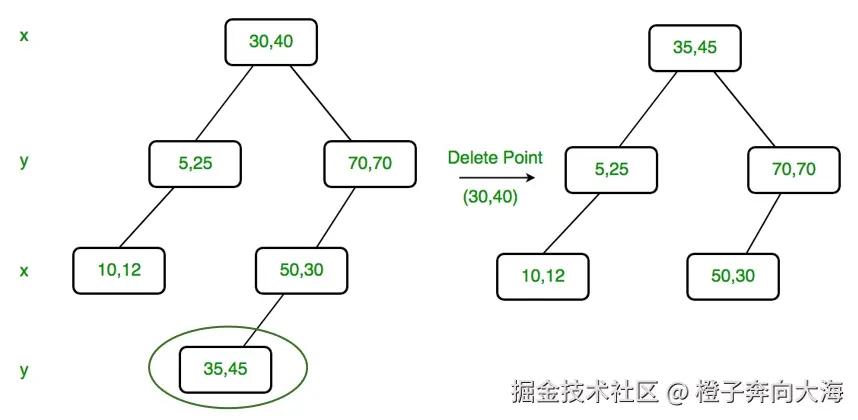KD Tree
What is KD tree
-
KD树是K-dimension tree的缩写,是对数据点在k维空间(如二维(x,y),三维(x,y,z),k维(x,y,z..))中划分的一种数据结构,主要应用于多维空间关键数据的搜索(如:范围搜索和最近邻搜索)。本质上说,KD-树就是一种平衡二叉树。
-
举个例子,大家可以看下面这张图片。
 对于平面点集的划分分为两种,按照x划分 (也就是图中竖线,将点尽量分为左右各一半)和按照y划分(也就是图中横线,将点尽量分为上下各一半)。
对于平面点集的划分分为两种,按照x划分 (也就是图中竖线,将点尽量分为左右各一半)和按照y划分(也就是图中横线,将点尽量分为上下各一半)。
- 再来一个更容易理解的例子,来自OI Wiki
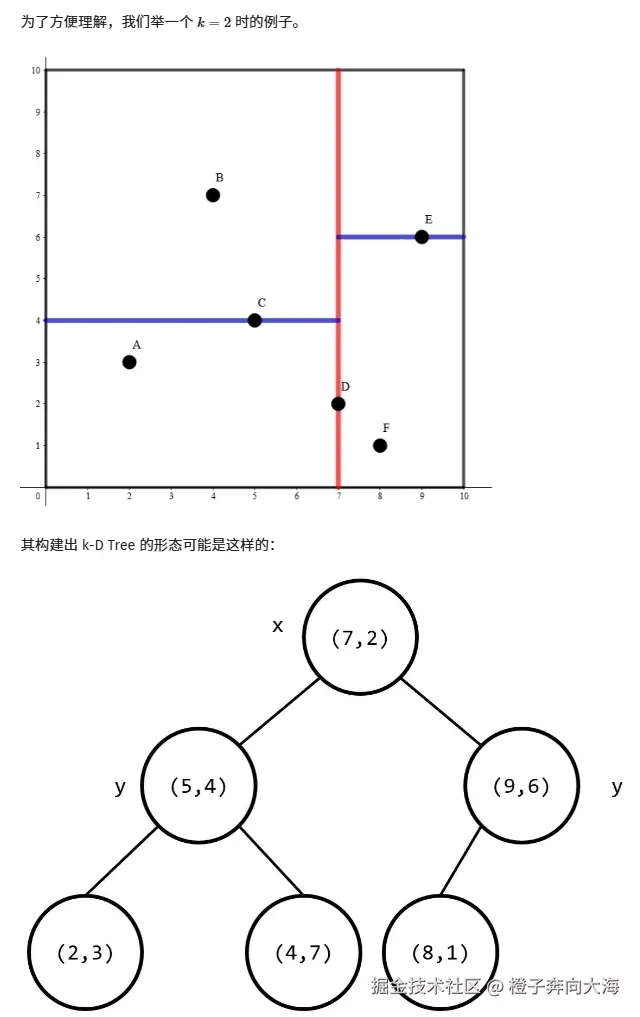
How to build KD tree
KD tree结构体组成
- Splitting axis
- Splitting value
- Data
- Left pointer
- Right pointer
构建策略
-
Divide based on order of point insertion
- 事先不知道点的整体分布,而是来一个点插入一个点
-
Divide by finding median
- 实现知道点的整体分布情况
-
Divide perpendicular to the axis with widest spread
- 分割的轴可能不交替
-
......
基于点插入的顺序进行划分
- 整体的构建思路其实就和在平面划分点集是一样的,先比较x坐标,再比较y坐标。
arduino
Node *insertRec(Node *root, int point[], unsigned depth)
{
if (root == NULL)
return newNode(point);
// 确定比较的维度
unsigned cd = depth % k;
// 与root的 cd 维数据进行对比
if (point[cd] < (root->point[cd]))
root->left =insertRec(root->left, point, depth + 1);
else
root->right =insertRec(root->right, point, depth + 1);
return root;
}
Node* insert(Node *root, int point[])
{
return insertRec(root, point, 0);
}- 例如,加入点的插入顺序为 (3, 6), (17, 15), (13, 15), (6, 12), (9, 1), (2, 7), (10, 19),那么构建的KD树应当展现为
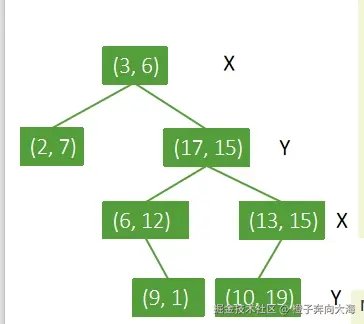
- 像二叉搜索树 (BST) 一样,我们期望插入操作的时间复杂度为O(log \ n),因为操作需要沿从根节点到叶节点的路径进行,而在平衡树中其深度为log \ n(其中 n 为节点数,等同于点的数量)。
- 然而,存在一个明确的退化情况:如果后续插入的点在每个维度上的坐标都持续增大,那么树结构就会退化成一条链(线形结构),其高度为 O(n)。考虑到节点深度累加1+2+···+n = O(n²),在最坏情况下,构建一棵 KD 树可能需要二次方时间。
- 然而很多情况下,我们都是已经知道点集的全体情况的,这时候我们就可以对算法进行优化来降低复杂度。
基于中位数的构建
-
关键在于将点集精确地均分到两个子树中,是理论上最优的分割策略。这意味着分割操作应当基于中位数(值)来进行。
-
下面给出一个构建示例。
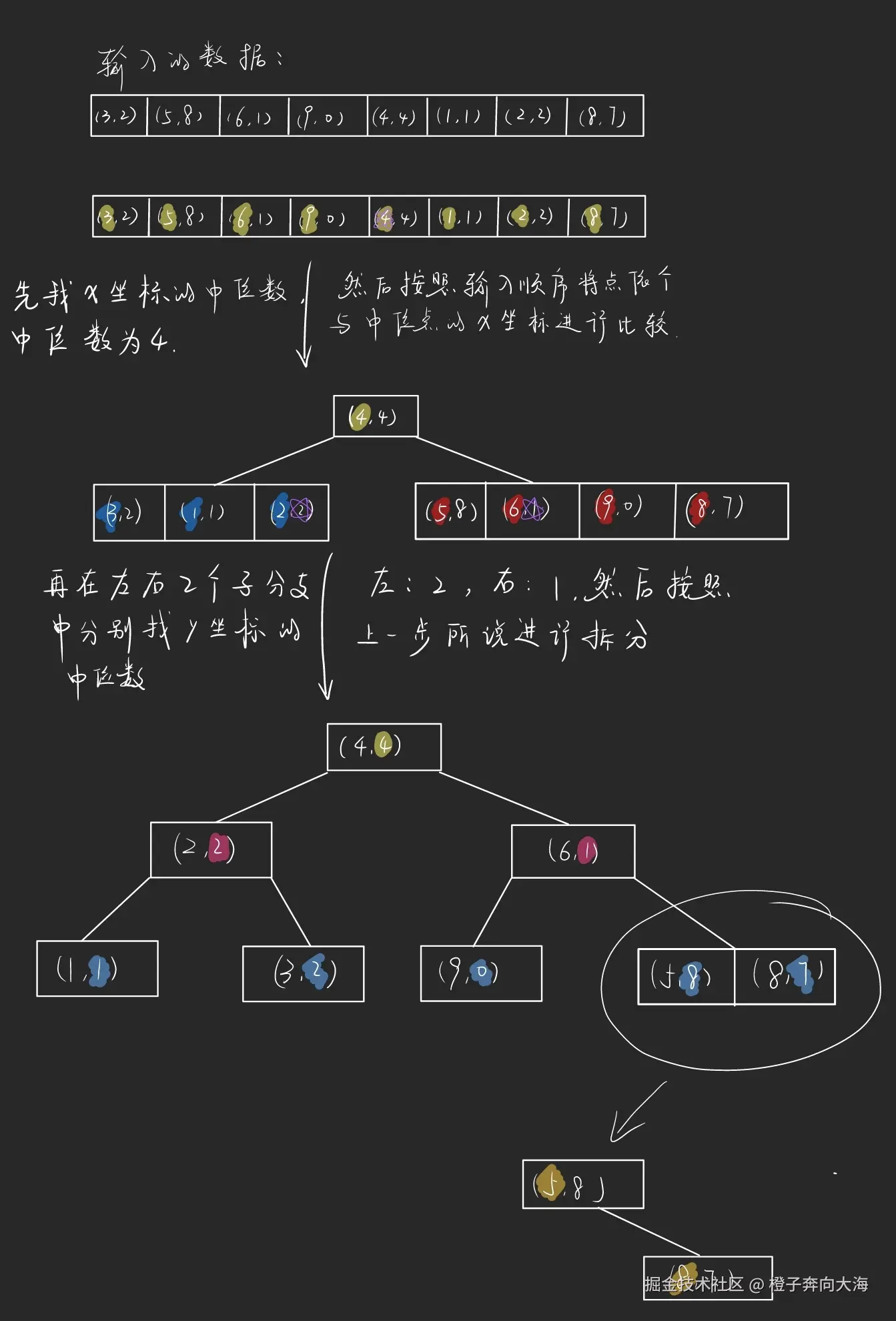
- 有人就问了,为啥这么麻烦啊,只通过x坐标排序不好吗?为啥还要弄个交替的?那么假如我们面临的数据是下面这样的,我们该如何建树呢?

- 依照姓名排序,找到中位值。

- 依据年龄排序,找到两棵子树的中位数。

- 最后就是依据绩点排序,我们来看一下整体步骤。
- 依照姓名排序,找到中位值。
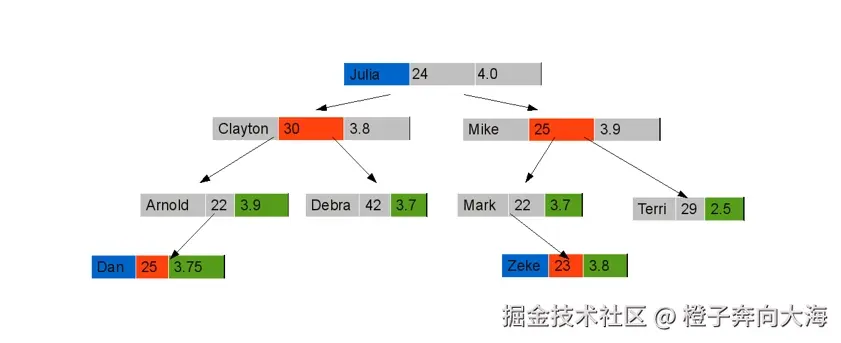
KD tree的Insert , delete和search
Insert
- 插入策略其实和构建策略一样,还是每个维度的数据依次比较,决定往左子树走还是往右子树走。
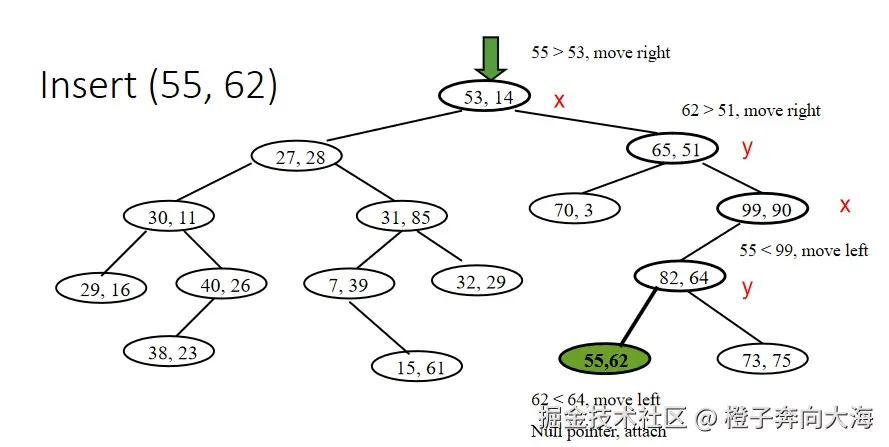
Delete
<math xmlns="http://www.w3.org/1998/Math/MathML" display="block"> 分割维度 c d = 结点深度 d e p t h % 空间维度数 k 分割维度cd=结点深度depth\ \%\ 空间维度数k </math>分割维度cd=结点深度depth % 空间维度数k
其实就是在决定到这一层的数据是依据x的顺序还是y的顺序还是别的维度的数据顺序。
-
如果当前节点不是要删除的节点
- 那么搜索找到要删除的点。
-
如果是当前结点是待删除结点
root且有右子树- 在
root的 右子树 中沿着当前维度cd查找 最小值 节点min。注意:这里是找右子树中cd维度上的最小值,这类似于二叉搜索树(BST)中用右子树的最小值(中序后继)来替换被删除节点。
- 在
-
如果是当前结点是待删除结点
root,没有右子树但是有左子树- 在
root的 左子树 中,沿着当前维度cd查找 最小值 节点min。 - 注意:这里的逻辑与标准 BST 删除稍有不同,标准 BST 在只有左子树时通常用左子树的最大值(中序前驱)替换。这里选择在左子树中仍然查找最小值。
- 在
-
如果是当前结点是待删除结点
root而且是叶子结点- 直接释放该叶子节点的内存。
arduino
Node *deleteNodeRec(Node *root, int point[], int depth)
{
// Given point is not present
if (root == NULL)
return NULL;
// Find dimension of current node
int cd = depth % k;
// If the point to be deleted is present at root
if (arePointsSame(root->point, point))
{
// 2.b) If right child is not NULL
if (root->right != NULL)
{
// Find minimum of root's dimension in right subtree
Node *min = findMin(root->right, cd);
// Copy the minimum to root
copyPoint(root->point, min->point);
// Recursively delete the minimum
root->left = deleteNodeRec(root->right, min->point, depth+1);
}
else if (root->left != NULL) // same as above
{
Node *min = findMin(root->left, cd);
copyPoint(root->point, min->point);
root->right = deleteNodeRec(root->left, min->point, depth+1);
}
else // If node to be deleted is leaf node
{
delete root;
return NULL;
}
return root;
}
我们来看两个例子。
